The terrible mine disaster at Monongah is still fresh in our minds, and it will remain fresh for many days, for the parties of rescuers have scarcely begun to find the bodies of the victims of that catastrophe. Every decade has its horrors, and every decade will have them until the end of time. It seems sometimes the decades that have passed and gone have been angelic compared to the present, but such is not the case.
While the terrible mine disaster of last week wiped out over five hundred lives (it was really closer to 400), the disasters of years ago were still just as severe not only in mining but at sea and in war and in pestilence and famine—- things in modern civilization has to a great extent overcome.

A New York correspondent, who was hurried to the scene by the recent big disaster by his paper, wrote a short description, a word picture of the plight of the women and children left to shift by the sudden taking off by their husbands and fathers and sons and brothers.
The men who died in the mine died a merciful fate as compared to the ones left behind. A flash, and it was all over, so far as they were concerned. They were stricken down in nearly every instance without a minute’s warning and in no time in which to suffer.
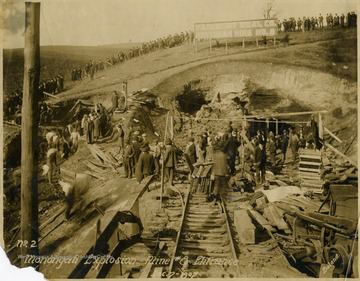

But up above, in the little mining town, were women and children whose sufferings would only be cured by time. Writing of these—the ones that bore the real suffering, the New York correspondent in his paper said: “The tragedy of the wives, the mothers, the sisters, and the sweethearts of his awful mine horror is the tragedy of the mine women the world over.” ( This article was printed on December 8, 1907, two days after the worst mining disaster [to this day] happened at Monongah, West Virginia)

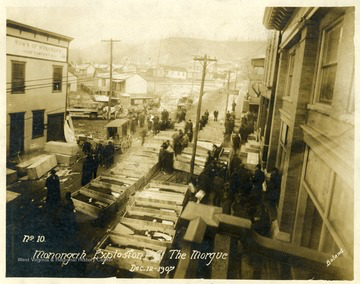
I am pretty sure almost everybody, at least in the mining community, has heard of the horrendous mining disaster at Monongah Mines 6&8 on the morning of December 6, 1907. It was and still is the biggest mining disaster ever to happen. A total of more than 350 miners lost their lives in a split of a second upon starting work that day. This catastrophic event would go on to make new safety requirements and regulations for mines all over the country.
My story today doesn’t deal with the mine disaster itself but instead with the widows and children of the deceased miners who were left behind. It was estimated that over three hundred widows and one thousand children would become homeless and penniless due to the explosion.
When this awful event happened, the wives, children, and neighbors rushed to the site of the mines to see what had transpired, and gazing upon the ghastly site, they soon realized that their lives had changed forever.
From eyewitness accounts, it was related that many of the wives were pregnant and soon to deliver. Because of the shock, many delivered the babies that day, and ultimately, some did not survive. Others delivered babies that would never know their fathers or brothers.
Meanwhile, as they were recovering the mangled bodies, the Fairmont Coal Company, who own the mines, were already planning what could be done to assist the widows left behind. They would be allowed to reside in the homes the company provided until the mines reopened, for then they would be needed for new employees. They would also continue to receive the loved one’s pay for a short time, but this was just a bandaid for a huge hole. What about the children who didn’t have a mother, and the father was all they had? Who would look after them?
The governor of West Virginia at the time was William Dawson, and as soon as he heard about the explosion, he traveled to Monongah to see exactly what had happened and find out what the state could do to help. Upon beholding the mass of women and children, sobbing and in shock, he sent out a message to the whole state to help in whatever way they could to provide relief for the wives and children who might end up on the street.
It was contemplated that there should be around 300 widows and somewhere around 1000 children soon to need help. The estimate of how much was figured at $200.000. That would provide each widow around $200, and each child would receive $100. They could never be sure how much the lost loved one would have made over their lifetime for sure, but this would provide a new start for them, hopefully.
Newspapers at that time seemed always to pick up stories and print them so their readers would know what was happening in other parts of the country. When the mine disaster occurred, the news spread from coast to coast. When it was discovered how many men had perished and how many wives and children were left behind, sympathy was widespread. The plea for relief circulated, and everyone wanted to help.
From at home in Monongah and Fairmont W.V., local women came and fed, cleaned, and watched children; they helped with the newborn babies and saw to the mother’s needs. Doctors and nurses arrived to tend to the sick and distraught and, in case, needed to apply medical care if anyone was brought out of the mine alive. It was stated that the trolley cars that day alone had over 5300 riders come from all over to help or be on site to look.
Miners from other states put down their pick axes and shovels and came to Monongah to help with rescue efforts. The amount of bodies that were recovered would provide too much work for local morticians, and others were sent for. If you could only offer to dig the many graves needed, everyone provided what they could.
All over the country, they heard the cries of the people who, up until then, lived as they did and, in the blink of an eye, lost everything, and their lives would never be the same. They needed money to start over, and many societies and organizations would put on shows and give the proceeds to the relief fund that had been set up. Churches would give their offerings from services and theaters, and even small children would give what they had to help. With everything that was going on, they almost forgot about Christmas and the children who still believed Santa would come. Businesses around the country sent toys, fruit, and nuts so that the children would have something under the tree on Christmas morning.
Food, such as flour, milk, and meat, was also packaged and delivered. Whatever was required or asked for was provided.
Everything that could be essential for the next few days was supplied. In the long term, money would be a necessity.
The owners of the damaged mines, The Fairmont Coal Co, gave $17,500 to the relief fund, and Senator Camden of W.V. donated $2,500. Kaufman Bros. [a department store] of Pennsylvania gave $200, Joseph Horne Co, also of Penn. gave $50, J.M. Hartley and Sons gave $100, Jacob and Hutchinson Hardware Co gave $100, E.C. Jones department store donated $50, Adoph Coors [the beer company] and even Theodore Roosevelt gave. The Elks Club collecting from brother sites managed to donate $1000, and the Bank of Wheeling sent $500. The relief fund was growing day by day. A man from Philadelphia who wanted to help but had little gave his only prized possession to a Jewler in Fairmont to be raffled off: a pair of solid gold cuff links. Amazing the generosity of West Virginia and Ohio, Missouri, Maryland, Rhode Island, Arizona, Alabama, New Mexico, New York, Mississippi, and even Wyoming.
The postmaster here at the time A. Howard Fleming was in receipt of the following letter from the private secretary of the Secretary of War, William H. Taft. My Dear Sir, I am directed by the Secretary of War to acknowledge receipt of your letter of December 21st and to enclose herewith his check for Fifty dollars as a contribution to the Monongah mine sufferers. Very Respectfully Yours Fred W. Carpenter Private Secretary.
Andrew Carnegie, the steel magnate of Pittsburgh, PA, was the largest contributor of all. Three years earlier, he had formed The Carnegie Hero Fund Commission, providing them with $500.000 to do with as they deemed necessary. Mr Carnegie asked them to donate $35,000 to the Monongah Mine Relief Fund.
The relief committee was hoping for a total of $200.000 but fell slightly under that total, raising $154,360.10. It’s still a hefty sum. The relief committee was in charge of handing out the money to those in need. Some had already left the area, and some had died, but they did the best they could to give to those who were listed at the time of the disaster.
The mine disaster turned 116 years old on Dec. 6, 2023. It will never be forgotten, especially in my husband’s hometown of Monongah, W.V. As bad as the catastrophe was, it showed the humanity of the American people. They will dig deep down and help when their fellow man is in need.
Below are some articles from various newspapers about the mine disaster and pictures from the time.
I hope this blog serves as a reminder of a time when our country took care of its own.
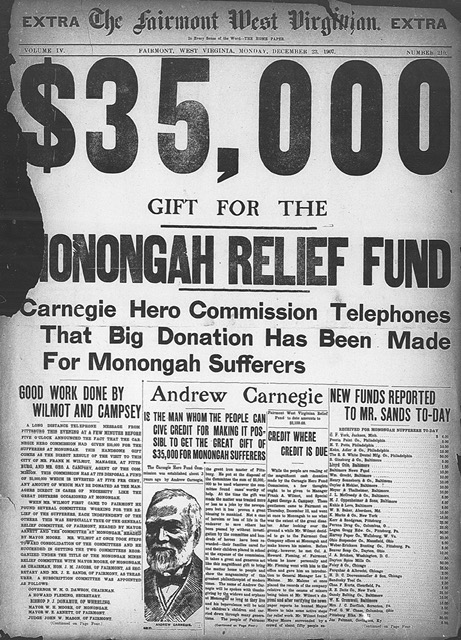
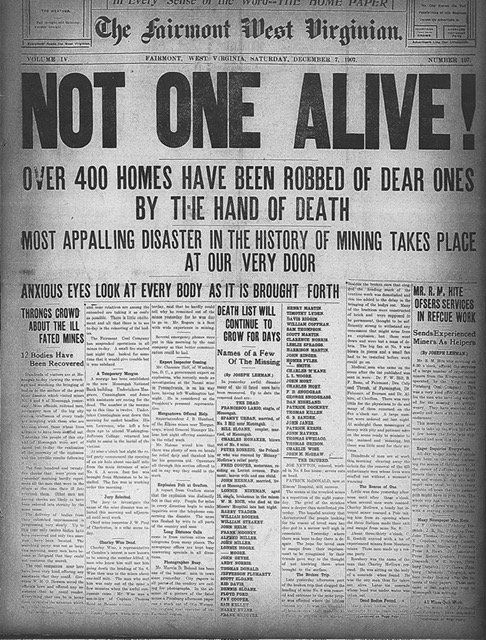
If you could

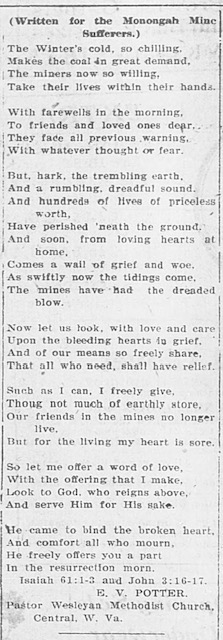
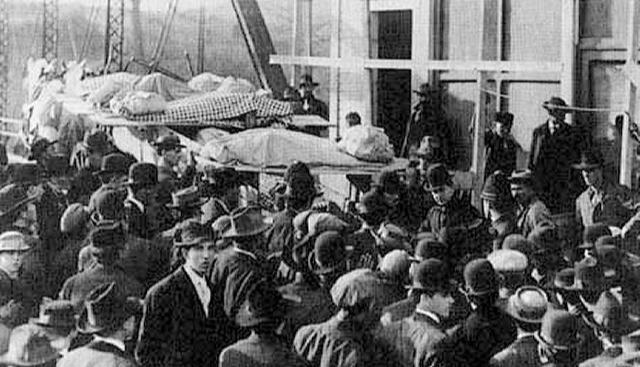
Please leave me a comment and let me know what you think about the blog, it helps make it better.
Remember without history we would never know how far we’ve come.

Excellent read! Thank you
Thank you! I’m glad you liked the blog.